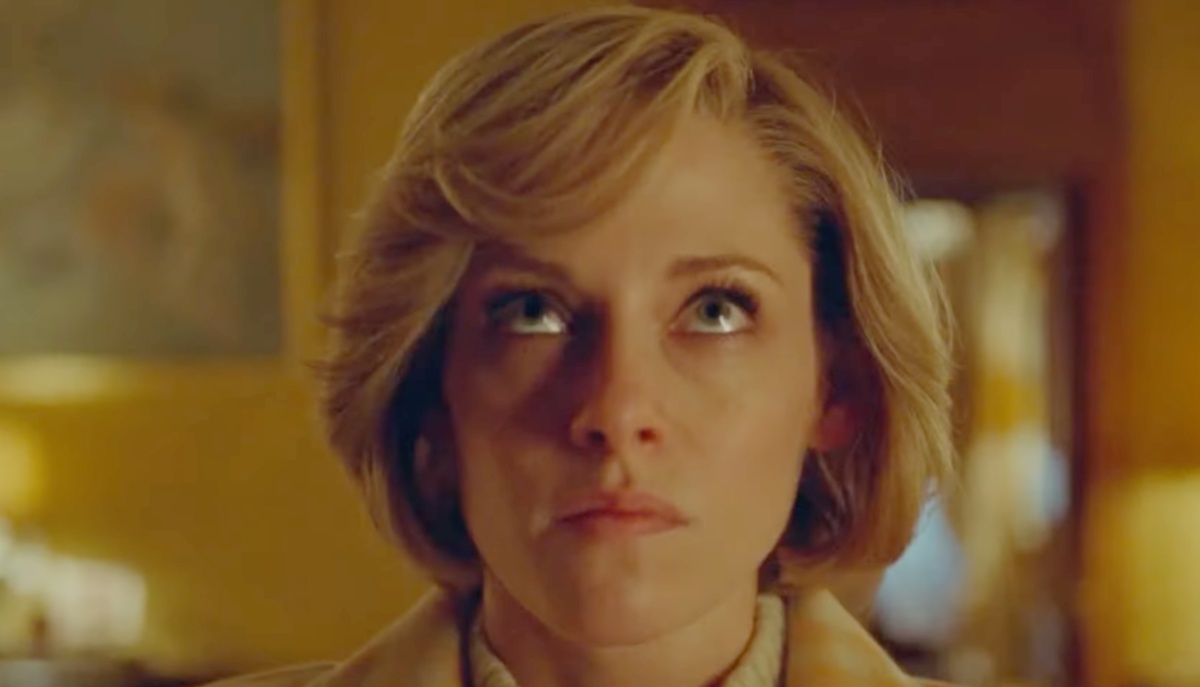Spencer Explores the Connection Between Diana and a Historical Rebellious Royal

Pablo Larraín’s haunting Diana biopic Spencer exudes a mystical, spooky aura, enhanced by a linkage to an ancient past.
As in one of the perfectly orchestrated meals at Sandringham (where the movie is set), in Spencer, all parts work towards giving back a collection of fragile fragments of Diana (Kristen Stewart) wrestling with her demons. These take on a tangible form when the princess becomes obsessed with another female royal: Henry VIII’s beheaded wife Anne Boleyn.
This unlikely, not always seamless connection starts when someone leaves a biography of Anne on Diana’s nightstand. The princess thinks overbearing equerry Major Alistair Gregory (Timothy Spall) must be behind this leather-bound omen, foreboding a grim fate one can spot well beyond the blanket of fog covering the estate’s grounds.
Diana sees the Tudor queen (played by The Nevers’ Amy Manson) in the cold corridors of the country mansion where the family is reunited to celebrate Christmas. A ghost inhabiting the deserted floors or a figment of Diana’s mind, Anne appears silently as the protagonist goes through a cycle of smothering traditions—some of which were so bizarre in truth that you couldn’t make them up, screenwriter Steven Knight has revealed.
Weighing guests on a pair of antique scales as they arrive and depart from Sandringham is a particularly controlling one, as Diana struggles with bulimia. Nonetheless, she is subjected to a never-ending, triggering sequence of lunches and dinners, performed as if the royals were constantly posing for visitors to barge into this house-museum.
The film builds upon the real myth of Diana, insisting on the pearl necklace, a choking proxy for her broken marriage to Charles (Jack Farthing) and the broken life she is striving to leave behind. Much like Anne, the necklace stays with Diana whether she wants it or not. A gift from Charles, this is a shiny reminder of the privileged life she would be called mad for rejecting and an almost literal leash—one whose clutch is getting tighter by the minute.
At dinner, Diana imagines vomiting fresh pearls in her pea soup, a series of rounded, pristine asteroids impacting the surface of an immovable green sea. This shocking, mesmerizing vision turns fine dining and delightful crockery into a disgusting spectacle, a sign of how luxury can be weaponized and turned into torture and control.
Diana’s polished image is a commodity. Everyone, from the people to those in the Firm, wants a piece of her—not the real one, of course. She is so heavily scrutinized that it is hard to tell when the princess is being herself and when she is trying to abide by the rules, often unsuccessfully. Diana and Anne Boleyn are perhaps similar in the way their personas have been pulled apart in the public eye: the former deemed too free-spirited and fragile, a loose cannon, and the latter accused of plotting and witchcraft, baseless claims that would lead to her incarceration and execution and would cement her in popular culture. Both women seen as frivolous, and a liability to the crown.
A recent biography of Boleyn tried to flip the script on the short-lived queen by highlighting her political activity. According to author Hayley Nolan in Anne Boleyn: 500 Years of Lies, Anne, like Diana, was focused on the people. Her humanitarian efforts—including pushing a forward-thinking anti-poverty law—have been drowned in the narrative of a cheating queen and recognized only as recently as 2019.
The parallelism between Diana and Anne sinks when the film throws Stewart’s Diana into Boleyn’s shoes to the letter. Diana wears Anne’s Tudor gown in a brief sequence that is long enough to be distracting and nearly ludicrous.
This moment aside, the association strangely works, adding an eerie and mysterious quality to Larraín’s biopic and hinting at a bigger issue at play. In Spencer, Anne isn’t just a symbol of female royals who have been treated unfairly. She stands for all powerful women in the public eye made to fit a certain mold. The harmful manner in which we tell female stories impacted Stewart, too, when she faced backlash over her affair with the Snow White and the Huntsman director in 2012.
The actress is the film’s undeniable star: This is every bit Stewart’s movie as it is Diana’s. It’s a melancholic, exquisite celebration of an icon in the making and the consecration of Stewart’s craft at once. She completely disappears as the people’s princess, immersing herself in the role until she sheds all of her to become all of Diana. It’s a painful process to behold as a viewer, let alone to go through as an actor.
Spencer is not the Diana biopic one would expect, and it will have some experts and royal fans turn up their nose at the artistic and historical license. But it’s also one of the most ambitious, atmospheric, spellbinding cinematic works you’ll see this year, a supernatural and yet deeply grounded take on a woman unraveling before our very eyes and fighting to stay whole.
Spencer is in cinemas now.
(image: Neon)
Want more stories like this? Become a subscriber and support the site!
—The Mary Sue has a strict comment policy that forbids, but is not limited to, personal insults toward anyone, hate speech, and trolling.—
Have a tip we should know? tips@themarysue.com